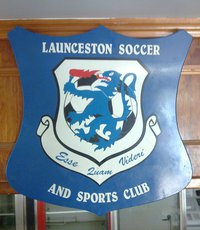Summary History of Launceston United’s Name
The first origins on the “Launceston United” name goes back to 1912 where early records of the Northern Tasmanian British Football Association shows a three team competition formed from only registered 65 players. The team names and home grounds were Elphin at Fry’s Paddock, Tamar at Cypress Street and the first Launceston United based at Windsor Park. Elphin and Tamar dominated the three team league between 1912 - 1914 with Launceston United invariably the wooden spooners. The period of the Great War has no recorded northern league competitions from 1915 – 1919, Launceston United’s name was last recorded as being used in 1918 when the club disbanded.
In the ensuring years between the two World Wars and early 1950’s, amalgamations and formations of new teams saw the absence of the Launceston United name for almost 40 years, emerging for a second time from 1956, the then club chairman, Mr Harold Jackson opened their new Cypress Street ground at Newstead that would be known as Ampol Park, most likely now know as Birch Avenue. Launceston United had put the emphasis on youth and they were to become the arch rivals to Juventus (now Launceston City) for the next two decades
The 1960’s are described as Tasmanian soccer’s golden era with registered players at an all time high and the state title changing hands many times. Many successful years would follow for Launceston United, both the Senior and Reserves teams winning the northern premiership titles in 1964. Proving premierships are hard to win it was a further three years before the Senior side was able to win the converted double of the Northern and State premiership titles in 1967. Players names of the time included the well known club identities of Jock Glass and Brian Dracup. The remainder of the 60’s and early 1970’s had Launceston United figuring highly in the league tables and United players representing Tasmanian teams playing international visiting teams. In the club’s trophy case, the NTBFA Linney-Barber Cup is last inscribed in 1971 with the club’s name although some records show Juventus as the winning team that year.
The 1970’s saw the introduction of two promotion/relegation divisions as a precursor to the introduction of a combined north/north-western league and a State-wide league of which Launceston United was one of the ten teams in 1978. The club was forced into a team “clear out” with many players preferring not to travel and signing with northern premier league clubs. Only four players were left from the previous season’s state league squad and the signed five promising youngsters from Matric College during the summer that would prove symbolic in the years ahead. The year saw Launceston United finish on the bottom of the State-wide League and they were relegated but not before taking some valuable scalps along the way.
The 1980’s is described as lacking inventiveness, leadership and a future strategic plan for the game in the state with high prize monies, transfer fees and bonuses it left clubs on the brink of closure and financial ruin. The league’s sponsorship money merry-go-round was also lacking and when the dollars all but disappeared so did the legion of paid soccer mercenaries from the state.
During the early 1980’s the Northern Div 1 League by formed by north and north west coast teams, Launceston United, Georgetown United, Launceston Juventus, Launceston Croatia, Riverside Olympic, Devonport, Ulverstone and Burnie United. The two Launceston United and Matric club teams were to become closer aligned with player transfers between the two ultimately leading a “marriage of convenience” merger in 1988 where United had the “ground” and Matric had the “players”. The merged clubs became known as the Launceston Soccer Club and the “united” name disappeared from the soccer scene.
The Launceston Soccer Club entered the new State-wide League for the 1989 season and competed well in the top flight league. But due to stretched resources, the committee of the time decided for the safety and stability of the local league in the respective northern competitions and won the Northern Premier League in 1993. In 1995 with the advent of a return to a winter competition from the summer state league, the club went back to the top flight and signed Ken Morton as coach but struggled with an abrupt turn over of players and once again voted to stay in the northern league to the present day.
The Launceston United name re-appeared in 2008 when the club committee decided to revive the “united” name to celebrate the 50th anniversary of the Launceston United, 40th anniversary of Launceston Matric and 30th anniversary on the merged clubs. The “third” coming Launceston United Soccer Club has given it a clear identity with it’s history as yet unwritten, what is written about the club in another hundred years will be determined by the people who are here today.
Written By:
Maurie Krushka
2011 Vice President
Launceston Soccer and Sports Club
January, 2011
(Acknowledgement – historical references in this document are taken from A Century
of Soccer – A Tasmanian History by Chris Hudson)
of Soccer – A Tasmanian History by Chris Hudson)
